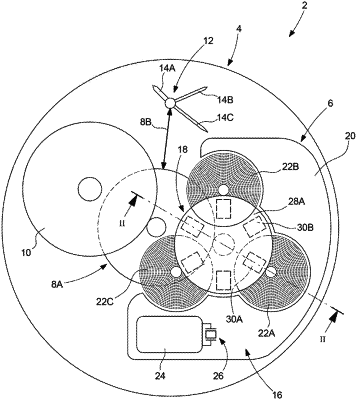| CPC G04C 3/16 (2013.01) [G04C 10/00 (2013.01); G04F 5/10 (2013.01)] | 12 Claims |

|
1. A method for controlling a timepiece (2) based on a medium frequency of a digital signal (SDP, SDI) which is derived from a reference periodic signal (SPR) generated by an oscillator (26) forming an electronic time base (25) of the timepiece (2), this timepiece comprising a movement (4) incorporating a mechanism formed by a kinematic chain (8) which is arranged between a motor device (6; 10) of the movement and an analogue time display device (12), the motor device being formed by or the kinematic chain comprising or the kinetic chain being kinematically linked to a continuous rotation electromechanical transducer (6) of which the medium rotational speed is regulated by a regulation device (50), associated with the electronic time base, according to a nominal rotational speed, this regulation device being arranged to successively supply to the electromechanical transducer regulation impulses (BPn) to regulate the medium rotational speed thereof, these regulation impulses defining respectively the same events (tf n) which are synchronised on the rising edges or on the falling edges of said digital signal and which are detectable, by a measurement device (70) without galvanic contact with the movement, at respective detection times having the same time phase-shift with said same events;
the method comprising the following steps:
A) successively supplying to the electromechanical transducer the regulation impulses (BPn) to regulate the medium rotational speed thereof, these regulation impulses defining respectively the same events (tf n) which are synchronised on the rising edges or on the falling edges of said digital signal;
B) measurement, without galvanic contact with the movement, of a plurality of successive time intervals (TIn) each occurring between two detection times which are detected for two respective regulation impulses among said regulation impulses;
C) determination, for each time interval of the plurality of time intervals, of a corresponding whole number (Mn(SDP), Mn(SDI)) which is equal to the rounded result (NRn(SDP), NRn(SDI)), to the nearest integer, of the division of this time interval by the theoretical medium period (PTDP, PMTDI) given by said digital signal;
D) summation of the whole numbers determined in step C) for the plurality of time intervals, to thus obtain a total number of periods of said digital signal;
E) summation of the measured time intervals of the plurality of time intervals, to thus obtain a total measurement duration (TMes) corresponding to said total number of periods; and
F) calculation of the medium frequency of said digital signal by dividing the total number of periods by said total measurement duration; and
G) controlling the timepiece to operate by correcting a number of inhibitions applied to the digital signal based determining that the calculated medium frequency is deviated from a predetermined value.
|